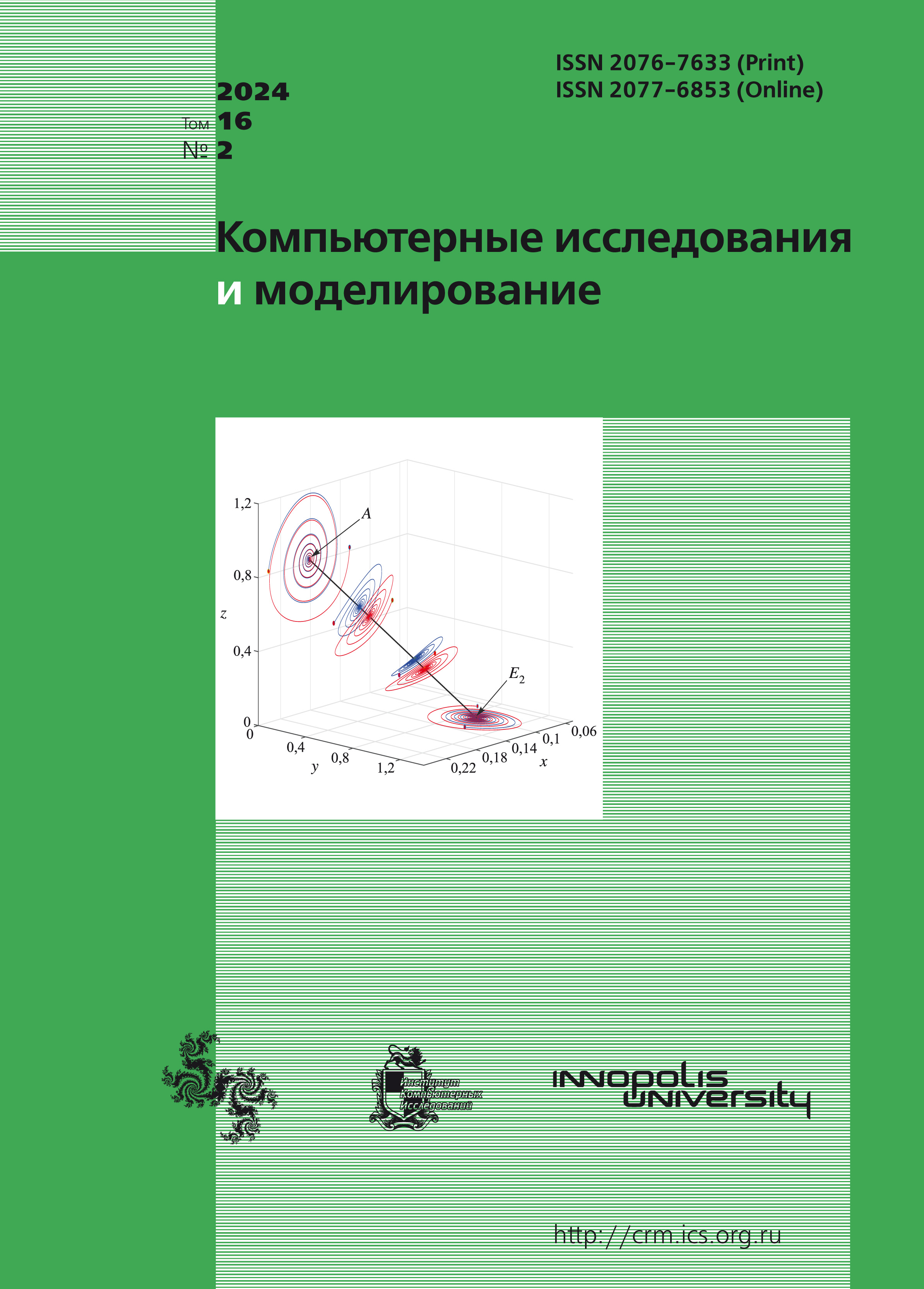Все выпуски
- 2024 Том 16
- 2023 Том 15
- 2022 Том 14
- 2021 Том 13
- 2020 Том 12
- 2019 Том 11
- 2018 Том 10
- 2017 Том 9
- 2016 Том 8
- 2015 Том 7
- 2014 Том 6
- 2013 Том 5
- 2012 Том 4
- 2011 Том 3
- 2010 Том 2
- 2009 Том 1
-
Nonlinear modeling of oscillatory viscoelastic fluid with variable viscosity: a comparative analysis of dual solutions
Компьютерные исследования и моделирование, 2024, т. 16, № 2, с. 409-431The viscoelastic fluid flow model across a porous medium has captivated the interest of many contemporary researchers due to its industrial and technical uses, such as food processing, paper and textile coating, packed bed reactors, the cooling effect of transpiration and the dispersion of pollutants through aquifers. This article focuses on the influence of variable viscosity and viscoelasticity on the magnetohydrodynamic oscillatory flow of second-order fluid through thermally radiating wavy walls. A mathematical model for this fluid flow, including governing equations and boundary conditions, is developed using the usual Boussinesq approximation. The governing equations are transformed into a system of nonlinear ordinary differential equations using non-similarity transformations. The numerical results obtained by applying finite-difference code based on the Lobatto IIIa formula generated by bvp4c solver are compared to the semi-analytical solutions for the velocity, temperature and concentration profiles obtained using the homotopy perturbation method (HPM). The effect of flow parameters on velocity, temperature, concentration profiles, skin friction coefficient, heat and mass transfer rate, and skin friction coefficient is examined and illustrated graphically. The physical parameters governing the fluid flow profoundly affected the resultant flow profiles except in a few cases. By using the slope linear regression method, the importance of considering the viscosity variation parameter and its interaction with the Lorentz force in determining the velocity behavior of the viscoelastic fluid model is highlighted. The percentage increase in the velocity profile of the viscoelastic model has been calculated for different ranges of viscosity variation parameters. Finally, the results are validated numerically for the skin friction coefficient and Nusselt number profiles.
Ключевые слова: viscoelastic fluid model, variable viscosity, Lorentz force, porous channel, oscillatory flow, HPM, heat transfer.
Nonlinear modeling of oscillatory viscoelastic fluid with variable viscosity: a comparative analysis of dual solutions
Computer Research and Modeling, 2024, v. 16, no. 2, pp. 409-431The viscoelastic fluid flow model across a porous medium has captivated the interest of many contemporary researchers due to its industrial and technical uses, such as food processing, paper and textile coating, packed bed reactors, the cooling effect of transpiration and the dispersion of pollutants through aquifers. This article focuses on the influence of variable viscosity and viscoelasticity on the magnetohydrodynamic oscillatory flow of second-order fluid through thermally radiating wavy walls. A mathematical model for this fluid flow, including governing equations and boundary conditions, is developed using the usual Boussinesq approximation. The governing equations are transformed into a system of nonlinear ordinary differential equations using non-similarity transformations. The numerical results obtained by applying finite-difference code based on the Lobatto IIIa formula generated by bvp4c solver are compared to the semi-analytical solutions for the velocity, temperature and concentration profiles obtained using the homotopy perturbation method (HPM). The effect of flow parameters on velocity, temperature, concentration profiles, skin friction coefficient, heat and mass transfer rate, and skin friction coefficient is examined and illustrated graphically. The physical parameters governing the fluid flow profoundly affected the resultant flow profiles except in a few cases. By using the slope linear regression method, the importance of considering the viscosity variation parameter and its interaction with the Lorentz force in determining the velocity behavior of the viscoelastic fluid model is highlighted. The percentage increase in the velocity profile of the viscoelastic model has been calculated for different ranges of viscosity variation parameters. Finally, the results are validated numerically for the skin friction coefficient and Nusselt number profiles.
Журнал индексируется в Scopus
Полнотекстовая версия журнала доступна также на сайте научной электронной библиотеки eLIBRARY.RU
Журнал входит в систему Российского индекса научного цитирования.
Журнал включен в базу данных Russian Science Citation Index (RSCI) на платформе Web of Science
Международная Междисциплинарная Конференция "Математика. Компьютер. Образование"






